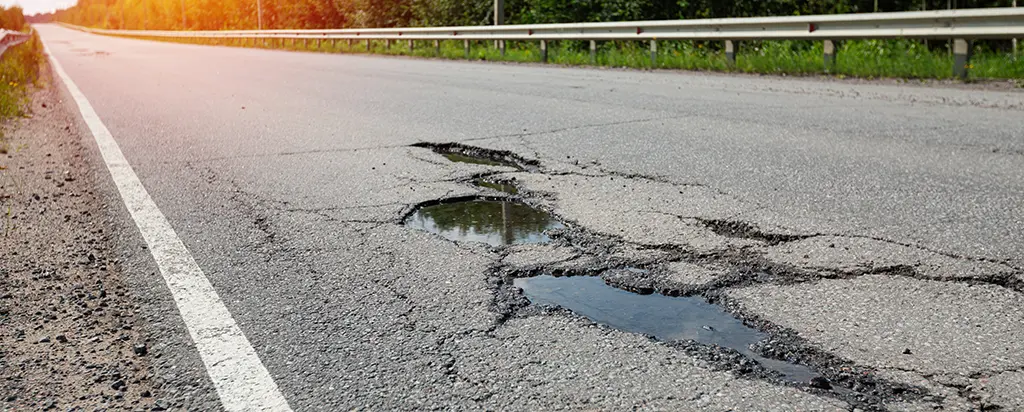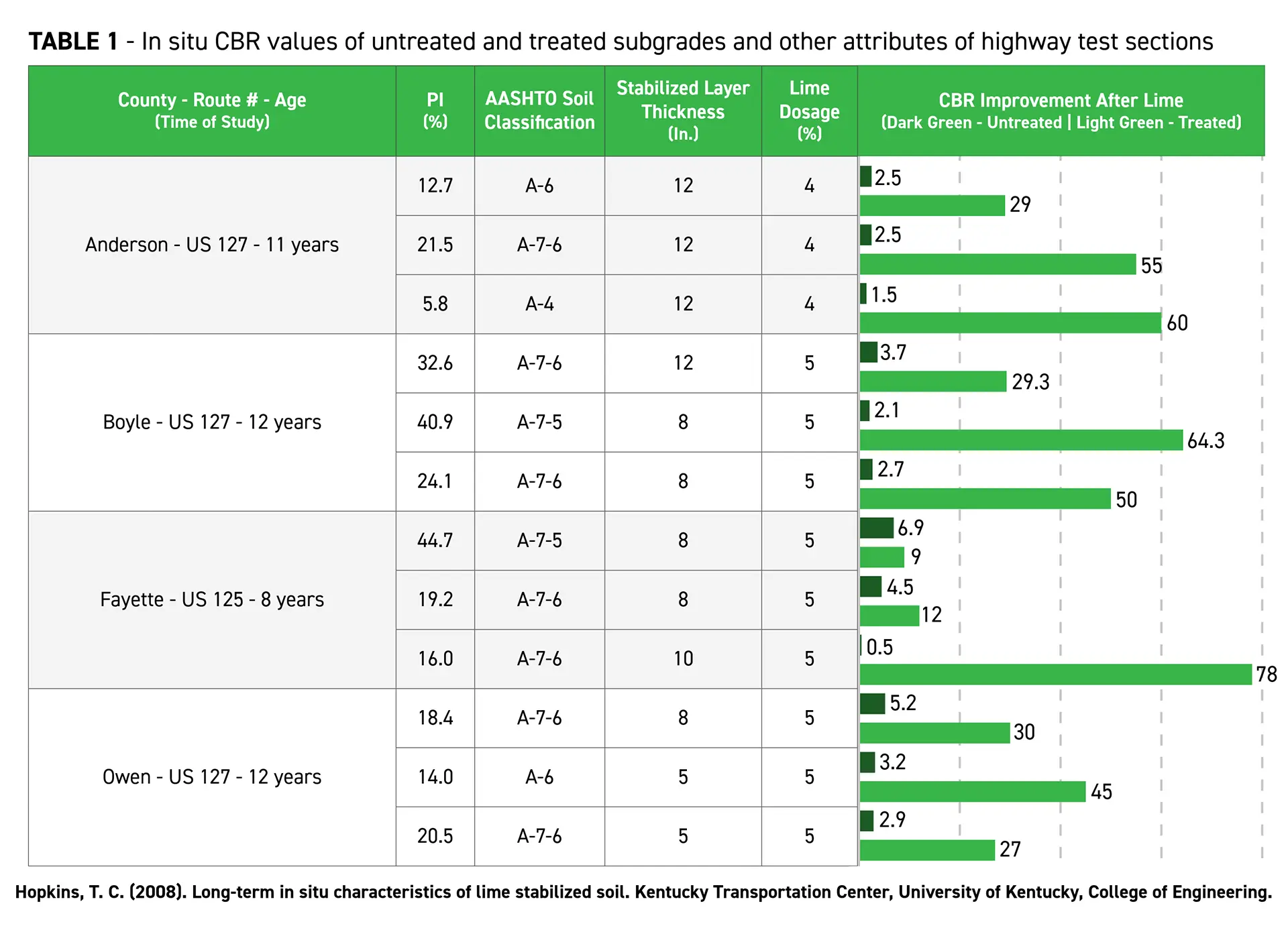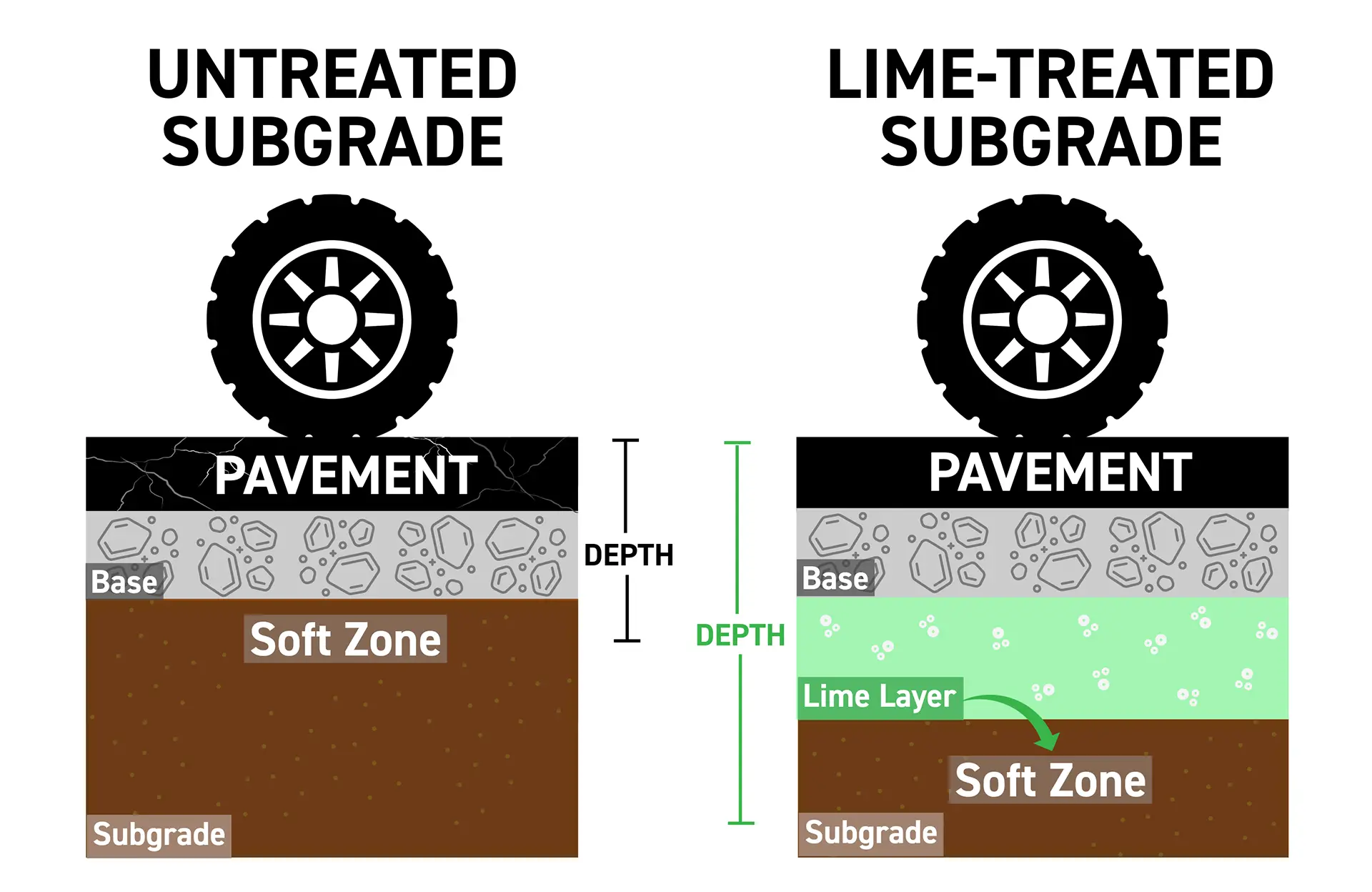Unlocking Pavement Potential: The Long-Term Value of Chemically Stabilized Subgrades

A Foundation in Crisis
America’s roadways are the backbone of its economy and daily life, yet they continue to show signs of chronic underinvestment. According to the American Society of Civil Engineers’ 2025 Infrastructure Report Card, the nation’s infrastructure earned a cumulative grade of C, its highest mark in decades, but still far from ideal. While overall infrastructure has seen modest improvements, the condition of the nation’s roadways remains troubling, earning a D+, with 39% of major roads rated in poor or mediocre condition.
Even with federal support from the Infrastructure Investment and Jobs Act, the nation’s roadways remain underfunded, falling $684 billion short of what’s needed over the next ten years. Federal funding alone is insufficient to close this gap, making smart, cost-effective design decisions more critical than ever. One of the most impactful and often overlooked strategies begins beneath the surface: chemically stabilized subgrades.
Get back to work with less downtime.
The Overlooked Power of Lime
Among chemical stabilization methods, lime treatment is frequently used to dry or modify wet soils during construction. However, its long-term stabilization benefits are often underestimated or entirely overlooked in pavement design. This oversight can lead to missed opportunities for improving pavement performance and reducing life-cycle costs. Lime-stabilized subgrades offer significant engineering advantages, including:
- Increased load-bearing capacity
- Reduced plasticity
- Improved resistance to moisture and freeze-thaw cycles
These enhancements translate into more resilient pavements that require less maintenance and deliver better value over time.
Evidence from the Field: Kentucky Transportation Center Study
The long-term benefits of chemically stabilized subgrades, particularly those treated with lime, are well-documented yet still underutilized in practice. Research from the Kentucky Transportation Center (KTC) provides compelling evidence of lime’s transformative impact. The KTC conducted a multi-year research initiative titled Long-Term Benefits of Stabilizing Soil Subgrades, aimed at evaluating the performance of chemically treated subgrades under real-world conditions. The study analyzed flexible pavement sections across Kentucky that had been in service for 8 to 15 years, comparing chemically-treated subgrades to untreated counterparts using field measurements, laboratory testing, and design modeling. The findings offer compelling evidence of the structural and economic advantages of lime stabilization:
Dramatic Increase in Load-Bearing Capacity
Kentucky’s untreated, clayey subgrades typically exhibit a California Bearing Ratio (CBR) of around 2, indicating poor support for overlying pavement layers. In contrast, chemically treated soils achieved CBR values 12 to 30 times higher, demonstrating a substantial improvement in strength and stiffness. For lime treated soils, this enhancement is due to lime’s ability to chemically bind moisture within the soil matrix, preventing it from weakening the material. The result is a uniform moisture and strength profile throughout the treated layer, even under varying environmental conditions, which directly translates to better load distribution and reduced pavement distress over time.

Validated Structural Layer Coefficients
Using the AASHTO relationship of layer coefficients and CBR, the KTC study proposed a layer coefficient (a₃) of around 0.11 for lime-treated soils, reflecting their contribution to pavement structure. Field measurements and back-calculations using actual pavement layer thicknesses and CBRs confirmed these values, with in-service coefficients ranging from 0.09 to 0.19. This consistency between design assumptions and real-world performance reinforces the reliability of lime stabilization in structural pavement design.
Improved Moisture Management and Soft Zone Mitigation
Moisture content at the base/subgrade interface – whether treated or untreated – is typically 3–4% higher than in the layers below. In untreated, clay-rich subgrades, this elevated moisture creates a “soft zone” near the pavement structure that is more prone to deformation under traffic loads. Lime stabilization helps relocate this vulnerable zone deeper into the soil profile, where stress levels are lower. By reducing stress on the weakest layer, this shift enhances pavement durability and contributes to longer-lasting performance.

Enhanced Modulus and System-Wide Structural Gains
Falling weight deflectometer (FWD) measurements used to back-calculate resilient modulus of the pavement layers showed that the modulus of chemically stabilized layers ranged from 21,600 to 130,000 psi as compared to untreated subgrades with values of 2,700 to 66,000 psi. As the modulus of the stabilized subgrade exceeds 27 ksi (186 MPa), the stiffness of the overlying granular base also increases. This interaction improves the overall structural integrity of the pavement system, allowing it to better resist deformation and fatigue over time.
Reduced Pavement Thickness and Construction Costs
When structural credit is given to the stabilized subgrade, designers can reduce the required thickness of asphalt or granular base layers. In the KTC study, this translated to potential asphalt reductions of 2–3 inches, which would have resulted in savings of $38,000–$57,000 per mile for a standard 36-foot-wide roadway when inflation is factored in. While material costs have evolved since the original study, the underlying principle remains valid: lime stabilization can reduce material quantities and construction effort, offering substantial cost savings that scale with project size.
Conclusion: Building Smarter from the Ground Up
As the nation continues to grapple with aging infrastructure and a widening funding gap, the need for smarter, more sustainable pavement design has never been more urgent. Chemically stabilized subgrades, particularly those treated with lime, offer a proven, cost-effective solution that enhances pavement performance, extends service life, and reduces long-term maintenance costs. Backed by decades of research and real-world performance data, lime stabilization stands out as a practical strategy to improve the structural integrity of our roadways from the ground up.
Call to Action
It’s time for agencies, engineers, and policymakers to rethink how we approach pavement design. By recognizing the structural value of stabilized subgrades and incorporating them into design standards and specifications, we can make meaningful strides toward closing the infrastructure gap. Through updated guidance, performance-based specs, and broader education on lime treatment’s long-term benefits, we can build roads that last longer, perform better, and cost less over time.
Resources
American Society of Civil Engineers. (2025). 2025 Report Card for America’s Infrastructure. ASCE.
Retrieved from https://infrastructurereportcard.org/
Hopkins, T. C., Beckham, T. L., Sun, L., Ni, B., & Butcher, B. (2004). Long-Term Benefits of Stabilizing Soil Subgrades (KTC-04-20/SPR247-02-1F). Kentucky Transportation Center, University of Kentucky.
Retrieved from https://uknowledge.uky.edu/ktc_researchreports/253
We're here to help you find the best solution for your next project. Let's get started. Give me a call at 937-641-9901.

Josh Weser
Mintek Resources
Related Posts
Building Big Starts Below Ground: Soil Strategies for Mega Projects
Mega construction projects come with unique soil challenges that can derail schedules and inflate budgets if not addressed early. Managing soil variability across hundreds of acres while achieving the bearing capacity required for massive structures demands a...
Cold Weather Liming for Construction Sites: Everything That You Need to Know
Winter construction doesn't have to mean costly shutdowns. Cold weather liming for construction sites leverages the exothermic reaction of lime-based products to dry, modify, and stabilize soils even in freezing conditions. This comprehensive guide covers the science...
Tariffs Disrupt Construction: Lime Keeps Projects Moving
Tariffs are reshaping the construction landscape. From cement and steel to aluminum and other essential materials, shifting trade policies are creating ripple effects across the industry. Even when prices hold steady, the uncertainty around future costs and sourcing...